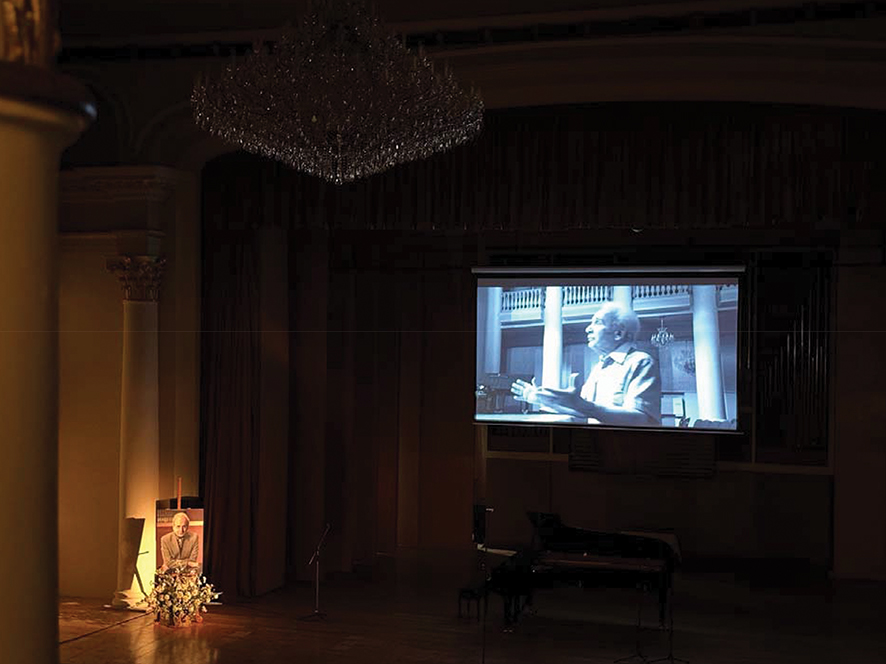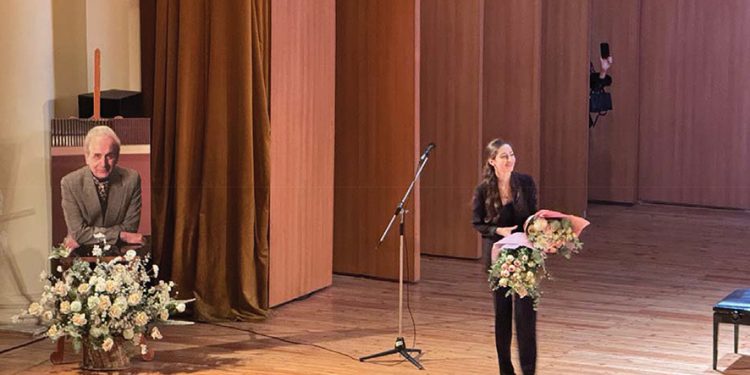The opening of the XII International Music Festival named after Tengiz Amirejibi on October 19, with Irma Gigani as the featured performer, presented a refined exploration of piano repertoire, merging late-Beethovenian introspection with Scriabin’s dramatic energy and Chopin’s lyrical finesse. Gigani’s carefully selected program invited the listener on a journey through complex emotional landscapes, from the philosophical depths of Beethoven’s Sonata No. 31 to the tempestuous yet lyrical forms of Scriabin and Chopin.
The Tengiz Amirejibi International Music Festival stands as one of Georgia’s most prestigious musical gatherings, celebrating the country’s rich cultural heritage while embracing the global world of classical music. Founded to honor the legacy of Georgian pianist and pedagogue Tengiz Amirejibi, the festival has grown into an essential platform for both emerging and established talents in the classical music scene. Amirejibi, a revered figure in Georgian musical life, was celebrated for his exquisite interpretations of Romantic repertoire and his contributions to the development of piano education in the country. His influence extended far beyond his home nation, and this festival, now in its 12th year, continues to embody his spirit of artistic excellence, bringing together world-class performers and music lovers alike.
Irma Gigani’s Pianistic Voice: Crafting Narrative through Structure and Emotion
Irma Gigani, known for her dynamic interpretative style and technical mastery, excelled in presenting a program that challenged the listener’s emotional and intellectual capacities. The progression of the concert—from Beethoven’s late works to Chopin’s mature voice—demonstrated Gigani’s grasp of the classical tradition while offering a journey into the Romantic expansion of musical language. Each piece represented a pinnacle of its composer’s achievement in the sonata form, unfolding a unique narrative driven by both structural innovation and deep emotionality.

The Inner Journey of Beethoven’s Sonata No. 31
Beethoven’s Sonata No. 31, Op. 110 stands as one of the composer’s final and most contemplative works, representing the end of a lifelong relationship with the piano sonata form. Gigani’s interpretation of the sonata emphasized the work’s spiritual and introspective qualities. The first movement, Moderato cantabile molto espressivo, often considered a dialogue between inward reflection and an almost conversational lyricism, served as an invitation to step into Beethoven’s world. Gigani’s ability to navigate this inner dialogue, allowing space for the melodic lines to breathe, proved crucial in setting the tone for the evening. Her approach favored subtle dynamic shifts that highlighted Beethoven’s late-period style, rich with harmonic exploration and thematic development.
In the Allegro molto, Gigani juxtaposed the playful and the forceful, drawing out sharp contrasts that kept the audience on edge. But it was in the final Adagio ma non troppo – Fuga where Gigani’s interpretative powers truly shone. The fugue, one of the most intellectually demanding movements in Beethoven’s sonatas, offered a challenge to the performer both technically and emotionally. Gigani balanced the mathematical rigor of the fugue with the sacred quality of its resolution, drawing connections between the formal and the spiritual—a challenge she fully embraced.
Scriabin’s Sonata No. 1: Tragedy and Triumph in Sound
Following Beethoven, Gigani’s interpretation of Scriabin’s Sonata No. 1 in F minor, Op. 6 marked a dramatic shift into the late-Romantic era, filled with intensity and conflict. This work, written early in Scriabin’s career, reflected his struggle with personal tragedy. Gigani’s performance of this piece highlighted the raw, emotional outpouring embedded in the music, especially in the first movement, Allegro con fuoco. The fiery passion, expressed through rapid scales and dissonant chords, demanded a level of physicality and emotional investment that Gigani delivered.
The second movement, Adagio, offered a brief moment of repose, where Gigani showcased her ability to sustain long, lyrical lines with a deep, singing tone. She then plunged into the stormy Presto and the tragic final movement, Funebre. Scriabin’s use of the sonata form was classical in structure but Romantic in execution, filled with harmonic tensions reflecting existential struggle. Gigani’s interpretation captured this duality, using her technical prowess to explore Scriabin’s harmonic language while maintaining the emotional weight of the work.
Chopin’s Mazurkas: Lyrical Reflections of a National Spirit
After the intermission, the mood shifted as Gigani moved into a set of Chopin’s Mazurkas, Op. 30 No. 1, Op. 30 No. 4, and Op. 17 No. 4. These miniatures, intimate reflections of Chopin’s Polish heritage, are filled with folk-inspired rhythms and harmonies. Gigani, with her deep understanding of lyrical expression, approached these pieces with a delicate touch, drawing out the dance-like qualities while infusing them with the subtle melancholy permeating Chopin’s music. The Mazurka in A minor, Op. 17 No. 4, offered emotional depth in just a few minutes, and Gigani’s sensitivity to phrasing and tempo conveyed its wistful, almost nostalgic mood.
Chopin’s Sonata No. 3 in B Minor, Op. 58: Virtuosity and Poeticism
Closing the program with Chopin’s Sonata No. 3 in B minor, Op. 58, Gigani faced one of the most technically demanding works in the piano repertoire. The first movement, Allegro maestoso, combined virtuosic runs with sweeping, lyrical melodies, offering Gigani a chance to display both technical brilliance and emotional depth. She balanced the bravura passages with moments of introspective calm, capturing the duality inherent in Chopin’s music.
The second movement, Scherzo: Molto vivace, provided playful contrast to the stormy first movement, where Gigani’s light touch and quick reflexes came to the forefront. But it was in the Largo, the emotional heart of the sonata, where Gigani’s interpretative depth truly stood out.
The final movement, Finale: Presto non tanto, brought the sonata to a virtuosic conclusion. Gigani’s technical mastery was on full display, bringing the concert to a thrilling and satisfying close, leaving an indelible mark on the audience.
Thematic and Emotional Cohesion
Irma Gigani’s performance at the opening of the XII International Music Festival named after Tengiz Amirejibi demonstrated her profound understanding of the piano’s expressive possibilities. Through the works of Beethoven, Scriabin, and Chopin, Gigani crafted a program that not only showcased her technical and interpretative abilities but also took the audience on a journey through some of the most profound emotional and philosophical landscapes in the piano repertoire. This unforgettable evening paid tribute to the legacy of Tengiz Amirejibi while setting the stage for the festival’s subsequent concerts.
By Ivan Nechaev














